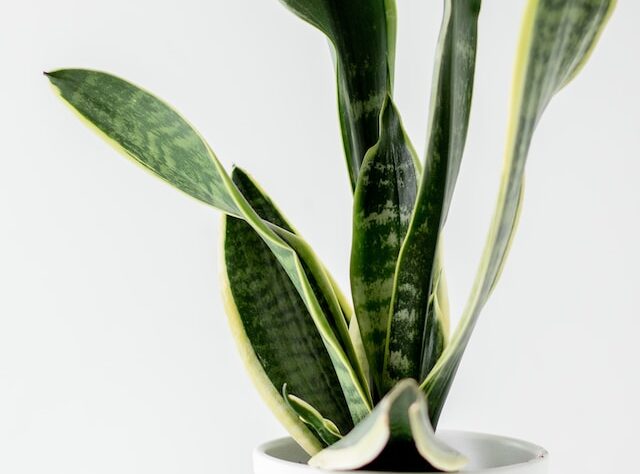
Snake plant, also known as Sansevieria or mother-in-law’s tongue, is a popular houseplant that is valued for its striking appearance and ease of care. Here’s some information about snake plants:
Appearance:
Snake plants have long, upright leaves that are typically green with yellow variegation, although there are also varieties with solid green or silver-gray leaves. The leaves are thick and stiff, resembling swords or snake tongues, which is where the plant gets its common name.
Benefits:
Snake plants are not only aesthetically pleasing but also have several benefits. They are known for their ability to purify indoor air by filtering out toxins such as formaldehyde, xylene, benzene, and trichloroethylene. They release oxygen at night, making them suitable for bedrooms. Moreover, snake plants are low-maintenance and can survive in various light conditions.
Growth habit:
Snake plants grow slowly and can reach a height of 2 to 4 feet (60 to 120 cm) when fully mature, depending on the variety. They propagate through rhizomes or leaf cuttings, making them easy to propagate and share with others.
Care:
Snake plants are relatively easy to care for, making them a popular choice for beginners and busy individuals. Here are some care tips:
Light:
They can tolerate a huge range of light conditions, from bright indirect light to low light. However, they bother medium to bright indirect light.
Watering:
Snake plants are drought-tolerant and are susceptible to overwatering. It’s best to allow the soil to dry out between waterings and avoid keeping them in soggy conditions.
Soil:
Well-draining soil is essential for snake plants. A cactus or succulent soil mix can works better.
Temperature:
Snake plants can tolerate a huge range of temperatures but prefer temperatures between 70-90°F (21-32°C).
Fertilizer:
They are not heavy feeders and can thrive without regular fertilization. If desired, you can use a balanced houseplant fertilizer at half strength during the growing season.
Propagation:
Snake plants can be propagate through the method of division or cutting of leaf. To propagate via division, carefully separate the root clump into smaller sections and repot them. For leaf cuttings, cut a healthy leaf into several sections and plant them in a well-draining potting mix.
Toxicity:
While snake plants are excellent air purifiers, they are toxic to cats, dogs, and some other pets if ingested. The plant contains saponins, which can cause gastrointestinal issues if consumed. It’s best to keep snake plants out of reach of pets or consider pet-friendly alternatives if you have curious animals at home.
Read about it: snake plant cons
Importance of Snake Plant
Here are some key points highlighting the importance of snake plants:
Air Purification:
Snake plants are renowned for their ability to purify indoor air. They have been extensively studied by NASA and found to effectively remove toxins such as formaldehyde, benzene, xylene, and trichloroethylene from the air. This makes them valuable in improving indoor air quality, reducing the presence of harmful pollutants, and creating a healthier living environment.
Oxygen Production:
Like other plants, snake plants undergo photosynthesis, a process in which they convert carbon dioxide into oxygen. Having snake plants in your home can contribute to increasing oxygen levels, particularly during the daytime. This can have a positive impact on overall air quality and human well-being.
Low-maintenance Nature:
Snake plants are highly resilient and require minimal care, making them popular among busy individuals or those lacking gardening experience. They can tolerate low light conditions, irregular watering, and neglect, making them an excellent choice for those who struggle to keep other plants alive.
Aesthetics and Décor:
Snake plants possess an attractive and distinctive appearance with their long, upright leaves and various color patterns. They can serve as eye-catching additions to indoor spaces, enhancing the visual appeal of homes, offices, or any other setting. They come in different sizes and varieties, offering versatility in styling and décor options.
Indoor and Outdoor Versatility:
Snake plants are primarily grown as indoor houseplants, but they can also be grown outdoors in warmer climates. They are commonly used as ornamental plants in landscapes and gardens, where they can be planted in the ground or in containers.
Health Benefits:
In addition to their air-purifying properties, snake plants are believed to have several health benefits. Some people claim that they can improve sleep quality, increase oxygen levels, and reduce stress and anxiety.
Psychological Benefits:
Indoor plants, including snake plants, have been associated with various psychological benefits. Studies have suggested that being around plants can promote relaxation, reduce stress levels, and improve mood. Snake plants, with their appealing greenery, can contribute to creating a calm and soothing atmosphere, which can be beneficial for mental well-being.
Adaptability:
Snake plants are adaptable to different growing conditions. They can thrive in various environments, including low light areas, which makes them suitable for spaces with limited natural sunlight. Their ability to tolerate drought and survive with infrequent watering further adds to their versatility.
Symbolic Significance:
In some cultures, snake plants are considered symbols of good luck, wealth, and positive energy. They are believed to bring prosperity and protective qualities to the spaces they inhabit. As such, they are often used as decorative elements or gifts for auspicious occasions.
In summary, snake plants play a vital role in improving indoor air quality, offering low-maintenance greenery, providing aesthetic appeal, and contributing to psychological well-being. Their adaptability and symbolic significance further enhance their importance as valued plants in various settings.






